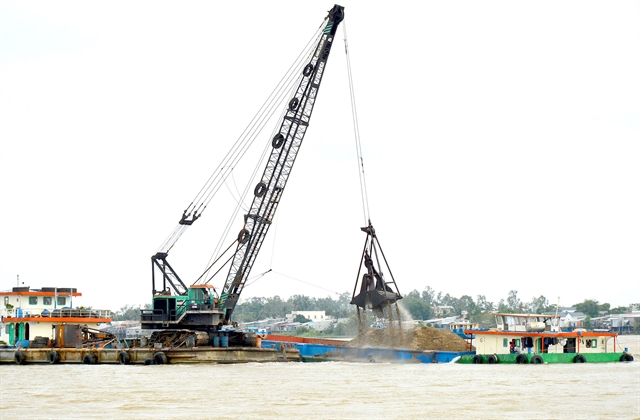
MEKONG DELTA — Many provinces of the Mekong Delta are facing a shortage of river sand that is affecting the completion of major construction projects.
In An Giang Province, a project to construct a bypass began in January, with a total investment of over VNĐ2 trillion (US$86 million). However, only 4 per cent of the targeted progress has been reached, due to a lack of river sand.
Phan Duy Lai, deputy general director of the Mỹ Thuận Project Management Board, said currently, only 5,000cu.m of river sand is transported to the construction site daily.
However, 8,000-10,000cu.m of river sand is needed per day to ensure the planned progress, he said.
In Vĩnh Long Province, data from the provincial Department of Natural Resources and Environment shows that the province is predicted to lack about 5.5 million cu.m of river sand for construction this year.
“The lack of river sand has significantly affected the progress of projects,” said Nguyễn Văn Tuấn, deputy director of the department.
In the meantime, the demand for river sand to serve construction projects in Cần Thơ City in 2022-25 is 34 million cu.m, though the current reserves in the city are reportedly not enough to meet the demand, Tuổi trẻ (Youth) online newspaper reported.
Causes
Vũ Văn Bình, head of the Sand Mining Management Office under Đồng Tháp Building Materials and Construction Joint Stock Company, said the company’s river sand exploitation productivity decreased by over one million cu.m this year, as localities with river sand mines closed them to keep the sand for other construction projects.
Huỳnh Văn Thái, head of the Minerals Office under the Natural Resources and Environment Department of An Giang Province, said: “The more we have major construction projects in the region, the more we lack river sand.”
This shortage also causes an increase in river sand prices, he added.
The reason for the increase is due to a mismatch between supply and demand, high fuel prices and the increased taxes on river sand, he said.
Solutions
The Department of Science and Technology under the Ministry of Transport has recommended using sea sand or saline sand to replace the river sand.
The department said that Sóc Trăng Province’s sea area is assessed to be available for sand exploitation to serve construction projects.
Besides, based on the recommendation, the Government has also approved a specific mechanism to increase the capacity of river sand mines in the region to meet the demand.
Localities are allowed to raise no more than 50 per cent of the capacity registered in the mining licence to serve the demand.
Trần Trí Quang, deputy chairman of the People’s Committee of Đồng Tháp Province, said the province has repeatedly proposed to relevant ministries to consider using other materials to replace river sand.
An official of the People’s Committee of An Giang Province said that Singapore and some countries around the world are using saline sand to make roadbeds.
He also suggested that the amount of muddy sand after dredging in the tributaries of rivers and canals in Việt Nam has not been utilised.
In the United States, there are additives to harden muddy sand to use in the construction sector, he said.
“We need to learn from them so that we have about 70 per cent of the material to replace river sand,” he said.
Another solution is that it could exploit sand in mudflats if it does not cause landslides or erosion, he said.
Associate Professor Lê Anh Tuấn of Cần Thơ University said when there are no alternative materials to replace river sand, we can limit the use of river sand through technical solutions, such as setting up pillars and building elevated roads to limit ground levelling activities that used river sand.
Tuấn also said it needs to limit the exploitation of river sand because it will worsen erosion in the delta.
Erosion
The delta is facing severe erosion along its rivers and coasts, affecting people’s lives and agriculture due to unsustainable sand exploitation over the past years, according to the Ministry of Natural Resources and Environment.
The country’s largest rice, fruit and seafood producer has 621 eroded sites with a total length of 610 kilometres along rivers and coasts by the end of last year, including 147 sites with a length of 127 kilometres that have been identified as extremely dangerous, and are mostly in An Giang, Đồng Tháp and Vĩnh Long provinces and Cần Thơ City.
Nguyễn Văn Tiến, deputy head of the Việt Nam Disaster Management Authority, said erosion along rivers and coasts also puts a severe impact on the delta’s environment and ecology.
In response to the situation, the Government had allocated more than VNĐ13 trillion ($570 million) since 2016 to mitigate the erosion, he said. — VNS
- Reduce Hair Loss with PURA D’OR Gold Label Shampoo
- Castor Oil Has Made a “Huge” Difference With Hair and Brow Growth
- Excessive hair loss in men: Signs of illness that cannot be subjective
- Dịch Vụ SEO Website ở Los Angeles, CA: đưa trang web doanh nghiệp bạn lên top Google
- Nails Salon Sierra Madre
 VnExpress News The News Gateway of Vietnam
VnExpress News The News Gateway of Vietnam





